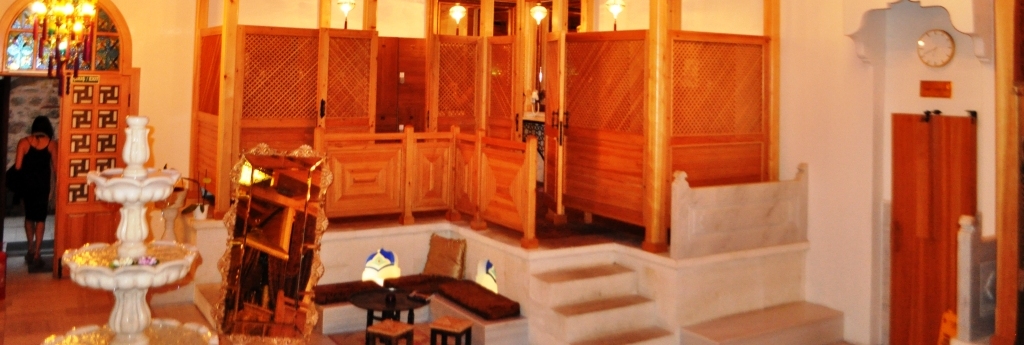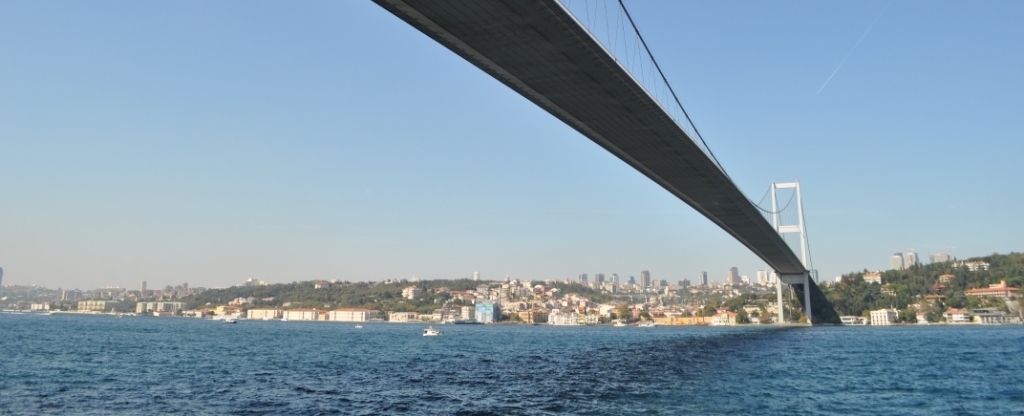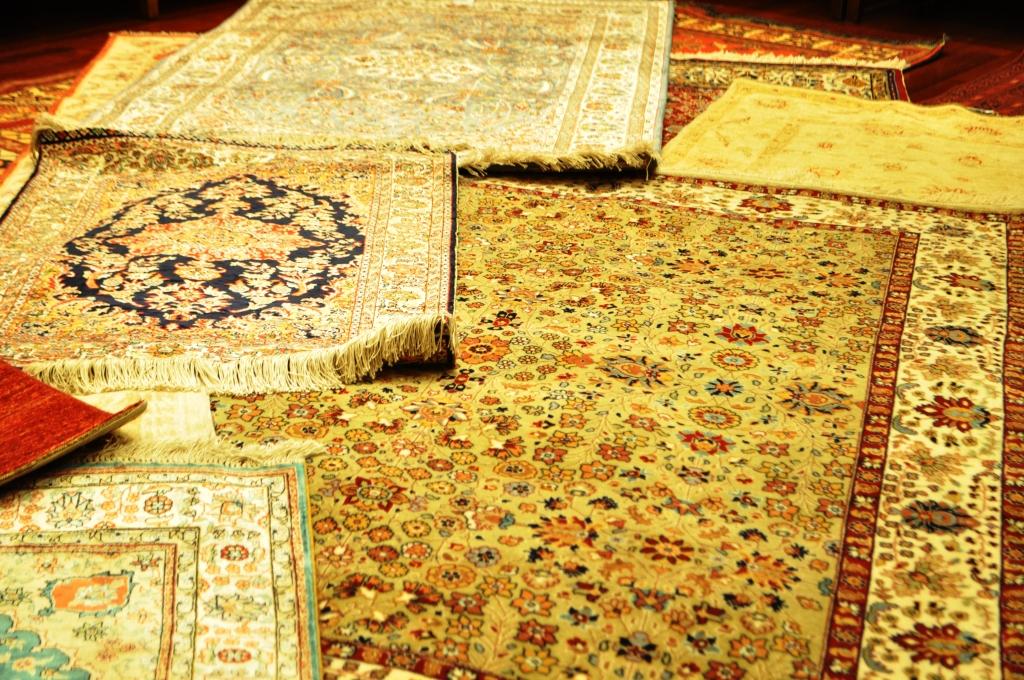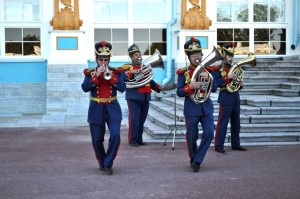
I’m a child of the Cold War: An eastern European refugee father, elementary school air raid drills, the certainty that whether it be the Cuban Missile Crisis, Prague Spring, the Vietnam War, or socialist Nicaragua, the Commies were coming.
So it seems frankly weird to be hearing a rendition of the “Spar Spangled Banner” played by a uniformed Russian brass quartet of buskers in front of Catherine Palace near St. Petersburg. A palace, I might add, that has hosted not only generations of tzars, but also Nazi occupiers, the communist elite, the post-communist elite (a 2005 party for restoration featured Tina Turner, Naomi Campbell, and Sting) and now lines upon lines of cruise ship tourists.
Sky-blue Catherine Palace is located in Pushkin, about 25 kilometers southeast of St. Petersburg (how long it takes you to get there will depend on traffic and your mode of transportation). And crowds or not, the palace is one of the highlights of a visit to St. Petersburg.
In Your Bucket Because…
- It is one of St. Petersburg’s iconic attractions.
- The. Amber. Room.
- Almost all of what you see is a minutely detailed reproduction of the original palace, looted in World War II, making this one of the largest, most expensive restoration projects in the world.
- Good for: history buffs, visitors enamored of royalty and palaces, and lovers of art and design.
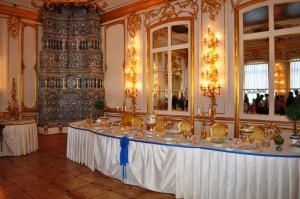
I was a little taken aback to learn that virtually all of what I was seeing, from the gild on the ceilings to the silk-papered walls to the furniture to the chandeliers to the table settings, was in fact a reproduction: Catherine Palace was almost entirely destroyed by occupying Germans during World War II, who looted and burned the palace. But after the initial disconnect — that none of what you are seeing is real — you might be even more mindboggled by the Herculean effort it took to put Humpty Dumpty authentically back together again, with almost all new pieces of eggshell.
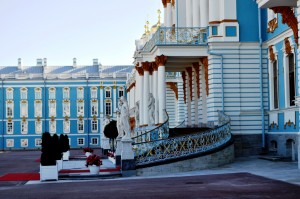
The biggest problem with visiting Catherine Palace is the crowds, especially during cruise ship season. (With the planned expansion of St. Petersburg’s docks, the problem of lines and crowds at the city’s main attractions can only get worse.) Lines to get in can be an hour or more: We were lucky, and waited only about 20 minutes. Once inside, we were ushered quickly through a set itinerary of rooms, each monitored by an unsmiling guard who kept traffic moving. Unlike, say, Versailles, it’s not a place that is easy to visit and be alone with your reflections about history and how people might have lived.
A Walk Through the History of Design
The blue facade of Catherine Palace (also called Tsarskoye Selo, which means “the Tsar’s Village”) makes it look like a fairytale palace on a bright summer’s day, with gold leaf glinting and paint matching the sky. The palace, which was built not for Catherine the Great, but rather for Catherine, Peter the Great’s wife, began as a modest palace constructed in 1717, which then expanded over several generations. Empress Elizabeth did the major expansion, engaging her court architect Bartolomeo Rastrelli to replace the old palace with a grander one in the flamboyant Rococo style.
Subsequent czars and czarinas left their mark by choosing decorations and furnishings of different styles, giving the place the feel of a museum of historical design: Dutch here, Italianate there, and so on The palace was indeed used by Catherine the Great, but according to Natasha, our guide, the second Catherine didn’t much care for its elaborate and gilded excesses. The Palace continued to be used by the royal family right up to the the Russian Revolution in 1917.
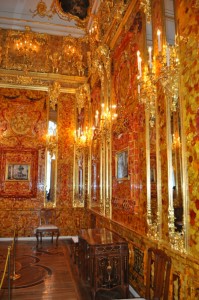
The most famous room in the palace is the Amber Room, whose walls are made entirely of Baltic amber. I’d been marveling at the abundant amber in every Baltic shop I’d visited, but the Amber Room was beyond imagination, every wall covered with panels made of the gleaming golden-orange rock, whose use in jewelry dates back 13,000 years to the Stone Age.
Natasha had told us that photography is permitted throughout Catherine Palace, and she even whispered to encourage us to be ready to take pictures as we were ushered into the Amber Room. However, immediately after snapping a photo, I was accosted by a very angry and stern Russian room monitor who ordered me to “take the film out” of my digital camera. Fortunately, the flood of humanity was pushing me through the line and away from the irritated guard, whose scowling demeanor exactly and unfortunately fit the stereotype of a old-time Soviet guard.
Outside as we left, the buskers were still playing. As we walked back to the bus, I heard “The Battle Hymn of the Republic.”
Practicalities
- A guided tour is the best way to go, but you’ll have to arrange an English language guide in advance through a tour agency, or perhaps through your hotel: You can go with a group, or privately. Pushkin also contains other palaces and parks that are well worth visiting, so check to see what else the tour includes (lunch, the gardens, and a tour of Pushkin are all possibilities on guided tours).
- Do not be tempted to try to tour Catherine Palace and Peterhof in one day: There’s quite a bit of travel in between, and there’s just too much to take in.
- Catherine Palace is open daily except for Tuesdays and the last Monday of every month. Opening hours are from 10 – 6 (entry stops at 5 p.m.). Independent tourists during the summer high season are only allowed to enter from 12 – 2 and from 4 – 5.
- Public transportation is available from St. Petersburg via several bus and train combinations.

